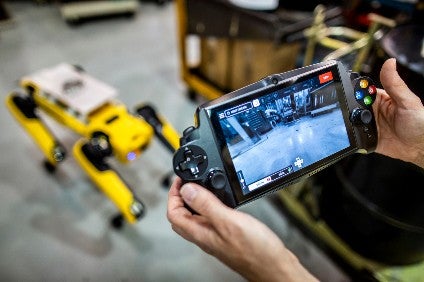
Ford is using four-legged robots at its US Van Dyke Transmission Plant in early August to laser scan the plant, helping engineers update the original computer aided design used for retooling plants.
The robots can be used in hard to reach areas within the plant to scan the area with laser scanners and HD cameras, collecting data used to retool the plants, saving engineers time and money.
Ford is leasing two robots, nicknamed Fluffy and Spot, from Boston Dynamics, known for building sophisticated mobile robots.
Although the dog-like robots can sit, shake hands and roll over, they can, more usefully to Ford, perform 360 degree camera scans, handle 30 degree grades and climb stairs for hours at a time.
The robots are bright yellow and easily recognisable. Equipped with five cameras, they can travel up to 3mph on a battery lasting nearly two hours and will be used to scan the plant floor and assist engineers in updating the original CAD.
“We design and build the plant. After that, over the years, changes are made that rarely get documented,” said Mark Goderis, Ford’s digital engineering manager.
How well do you really know your competitors?
Access the most comprehensive Company Profiles on the market, powered by GlobalData. Save hours of research. Gain competitive edge.

Thank you!
Your download email will arrive shortly
Not ready to buy yet? Download a free sample
We are confident about the unique quality of our Company Profiles. However, we want you to make the most beneficial decision for your business, so we offer a free sample that you can download by submitting the below form
By GlobalData“By having the robots scan our facility, we can see what it actually looks like now and build a new engineering model. That digital model is then used when we need to retool the plant for new products.”
Without Fluffy, the update would be far more tedious.
“We used to use a tripod, and we would walk around the facility stopping at different locations, each time standing around for five minutes waiting for the laser to scan,” Goderis recalled.
“Scanning one plant could take two weeks. With Fluffy’s help, we are able to do it in half the time.”
The old way also was expensive – it cost nearly US$300,000 to scan one facility. If this pilot works, Ford’s manufacturing team could scan all its plants for a fraction of the cost.
This cutting-edge technology helps save the automaker money and allows it to retool facilities faster, ultimately helping bring new vehicles to market sooner.
In time, Goderis says, the intent is to be able to operate the robots remotely, programming them for plant missions and receiving reports immediately from anywhere in the country. For now, the robots can be programmed to follow a specific path and can be operated from up to 50m away with a tablet application.
The key to Fluffy and Spot’s success is their agility. Should an issue occur, a control device has a safe stop that stops it from colliding with anything.
The robots have three operational gaits – a walk for stable ground, an amble for uneven terrain and a special speed for stairs. They can change positions from a crouch to a stretch, which allows them to be deployed to difficult to reach areas within the plant. They can handle tough terrain, from grates to steps to 30degree inclines. If they fall, they can right themselves. They maintain a safe, set distance from objects to prevent collisions.
Sometimes, Fluffy sits on its robotic haunches and rides on the back of a small, round autonomous mobile robot, known informally as Scouter. Scouter glides smoothly up and down the aisles of the plant, allowing Fluffy to conserve battery power until it’s time to get to work. Scouter can autonomously navigate facilities while scanning and capturing 3D point clouds to generate a CAD of the facility. If an area is too tight for Scouter, Fluffy comes to the rescue.
“There are areas in the plant that you might not want to walk into because they might be tough to manoeuvre,” Ford said. “It’s easier and safer to send Fluffy back there.
“Fluffy is an amazing manufacturing tool. Yes, it’s interesting and new, but Fluffy should really be valued for his work and tenacity. He can do so much more than dance and roll over. We want to push him to the limits in the manufacturing plant and see what value he has for the company.”







